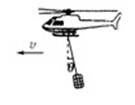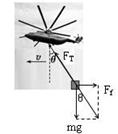问题
选择题
如右图所示,一运送救灾物资的直升飞机沿水平方向匀速飞行.已知物资的总质量为m,吊运物资的悬索与竖直方向成θ角.设物资所受的空气阻力为F阻,悬索对物资的拉力为F,重力加速度为g,则( )

A.
B.
C.F=mgcos θ
D.
答案
答案:B
题目分析:以物资为研究对象,分析受力情况:重力mg、悬索对物资的拉力 ,空气阻力
,空气阻力 ,根据平衡条件得知:mg与
,根据平衡条件得知:mg与 的合力与
的合力与 小相等,方向相反,则有
小相等,方向相反,则有
故选B.

点评:本题是实际的情景,实质是简单的物体平衡问题,分析受力、作出力图是关键.
